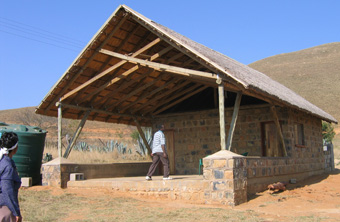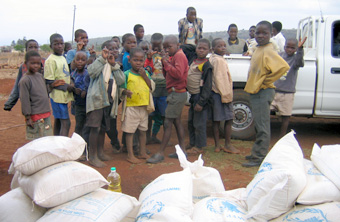In times gone by, the ‘KaGogo’ (literally ‘grandmother’s house’) was an integral part of every Swazi homestead – a place of refuge or a neutral site for discussing family matters and resolving disputes. Now the spirit of ‘KaGogo’ is being revived as a way of mobilizing communities in the response to HIV.
Heralded as an example of ‘best practice’ by UNAIDS, KaGogo social centres are being constructed across the country to serve as a meeting place for orphaned children where HIV prevention, care and support activities can take place. Often centres are doubling up as ‘Neighbourhood Care Points’, where education and food are provided.
“Using KaGogo social centres as part of the AIDS response in Swaziland is a new initiative based on traditional ways which people understand and respect,” said UNAIDS Country Coordinator in Swaziland, Mulunesh Tennagashaw. “They empower local communities to look after their orphaned children within their own traditional structure.”
The KaGogo centres respond to the need to support the overwhelming numbers of orphans in Swaziland. There are currently an estimated 63,000 children orphaned by AIDS and extended families are finding it increasingly difficult to cope.

One of the new 'KaGogo' social centres in Swaziland, traditional meeting places now being used to provide essential services for orphaned children.
Credit: UNAIDS/R. EvansConstruction of the centres began in 2003 and the KaGogo programme has made huge progress in a very short time. So far 50% of the centres have been completed nation-wide, and a further 30% have been constructed up to roof level. All the KaGogo social centres in Swaziland have been built by the communities themselves who provided labour and local materials.
Mambane’s KaGogo Centre
The KaGogo centre in the Mambane Community, Lubombo region—one of the most remote, poorest and driest parts of Swaziland—is built solidly out of local stone and has a large, airy veranda where meetings are held. It also doubles up as the Neighbourhood Care Point where food and education are provided—the only one in the community.
Under the thatched veranda about 40 children sit on plastic chairs doing sums in shared, well-thumbed maths sheets. The children range in age from seven to 17 years of age. For these and over 40 others registered with the centre, these represent their only school lessons. In addition to educational support, the children are provided with two meals of maize porridge and bean soup a day.
Lungile Matse is one of the volunteer teachers and a caregiver at the KaGogo centre. Recently widowed, and with five children of her own to care for, she still finds time to come to the centre every morning, five days a week.
Lungile and the other volunteers teach maths, siSwati and English using work sheets and books provided by UNICEF. The education they provide here is designed for children of primary school age who haven’t had the chance to go to school, but several of the children attending are older.
A chart on the wall shows that 18 of the children have no parents or are ’double orphans’. Twenty-three have only one parent and 42 are classified as ’vulnerable’. Carers say that many more children would like to come to the centre but live too far away or are too young.
The Mambane community has been badly hit by recurrent drought in recent years, leading to a growing food crisis. The KaGogo social centres have become a central point for distribution of emergency food. UNAIDS Cosponsor organization, the World Food Programme has been providing food at the Mambane centre since July 2005.

World Food Programme has been providing food to the KaGogo in Mambane since July 2005
“Other hungry children come here looking for food,” said Busisiwe Mazibuko, another of the caregivers. “But we only have enough to give the children here. It’s very hard to turn the other children away but we can’t feed more. We have been trying to grow vegetables for the Care Point, but water is scarce and we don’t have enough seeds.”
In Mambane and across Swaziland, it is envisaged that the community KaGogo social centres will eventually be able to provide other essential services for orphaned and vulnerable children, whilst enabling them to continue living in the community they belong to. Whilst the centres can be used for pre-schooling and non-formal schooling, both for children and adults, the Government is keen that KaGogo centres should be used prepare children for school and channel them into mainstream education.
“I believe the orphans of my areas should be looked after by the people of that community, and not somebody else. We can sustain these kids of ours in the community, using community resources and land. I strongly believe that as a community, we can solve most of the problems, provided we are given financial support,” said Chief Sipho Shongwe, Minister of Health and Social Welfare.
The National Emergency Response Council for HIV and AIDS in Swaziland (NERCHA) and the Global Fund to Fight AIDS TB and malaria provided financial and technical contributions to the KaGogo Social Centre initiative. The estimated cost of each centre is US$ 10 000.
Related links
Helping Ourselves: Community Responses to AIDS in Swaziland
More on Swaziland
World Food Programme
The Global Fund to fight AIDS, Tuberculosis and Malaria




